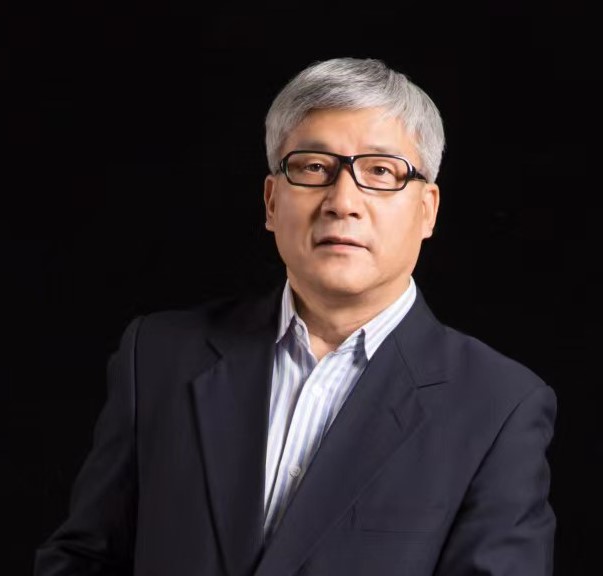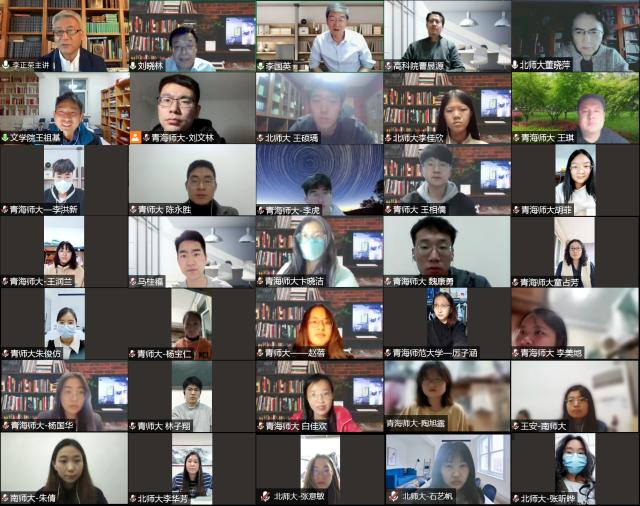青海师范大学中国语言文学一级学科研究生通识课程
“跨文化中国学研究方法论”第八讲
李正荣教授《陀思妥耶夫斯基小说的黑、白和灰度》

主讲教授简介:李正荣,北京师范大学教授,俄罗斯文学研究专家。北京师范大学跨文化研究院副院长、北京师范大学基督教文学研究中心主任。高校外国文学教学学会常务理事。主要出版著作有《托尔斯泰传》、《托尔斯泰的体悟与托尔斯泰的小说》等多种,整理出版其导师刘宁先生的遗著《跨文化俄苏文学访谈录》。获俄罗斯文学会颁发的莱蒙托夫奖章,多次获北京市优秀教学成果奖。李正荣教授在“教育援青”人文学科建设基础用书中撰写并出版《俄罗斯十九世纪文学十讲》,并为青海师大文学院研究生授课,共两讲,本次是第一讲。
2022年4月30日,青海师范大学中国语言文学一级学科“跨文化中国学研究方法论”研究生课开始第八讲,北京师范大学李正荣教授主讲,题目为《陀思妥耶夫斯基小说的黑、白和灰度》。青海师范大学文学院,青海师范大学民族师范学院、青海师范大学高原科学与可持续发展研究院、北京师范大学跨文化研究院师生听讲,南开大学、南京师范大学、四川外国语大学、重庆外国语学院、宁夏大学等多所高校师生也闻讯前来听课,现场师生近百人。青海师范大学文学院副院长刘晓林教授主持本课。
李正荣教授在本讲中始终贯穿一个深刻的命题:要跨文化?还是要壁垒?他从意大利街头墙面艺术家乔利特·阿戈兹和俄罗斯画家别洛夫分别于2022年和1872年创作的两幅陀思妥耶夫斯基的画像比较开始,在两者相差150年的时空范畴内,分析一位俄罗斯伟大作家陀思妥耶夫斯基的不朽作品与巨人思想。在长达三个小时的授课中,他使用这一个案,将俄罗斯文学、跨文化学与图像学的研究相结合,开展跨文本的分析,阐释对这个关乎人类共同命运的问题的思考。以下是要点。
跨文本分析之一:走出俄罗斯,以150年为中时段,分析意大利艺术家乔利特·阿戈兹画作要表达的观点。意大利艺术家认为:“文化是一种普遍的价值观”。陀思妥耶夫斯基是 “全人类的财产”。其《罪与罚》和《白痴》是旷世杰作,与别洛夫的画作一样永不磨灭。
跨文本分析之二,对作家人生进行短时段研究。陀思妥耶夫斯基生于壁垒森严的世界,东与西、南与北、左与右、上与下、健康与疾病,生与死,壁垒重重。他以文学打通地理、历史、文化和心理的壁垒,带领读者透过艺术的本质看世界。托尔斯泰在陀氏身后写了《论生命》一书,指出生命有肉与灵的差别,肉体生命存亡寂灭,精神生命永存。陀思妥耶夫斯基也经历过崇高与卑劣的分裂人生,于是他更加渴望冲出壁垒。李教授说,作品分析是否要将作家人生当作要素可以讨论,但将一位二百年前的作家人生作为一种跨文本来分析时,却能让师生切近地感受作家对逃出壁垒的强大渴望与对世界进步的追求。俄罗斯当代学者谢尔盖·基巴里尼克是《陀思妥耶夫斯基全集》的主编和研究者,从他的研究看,把短时段的文本与中时段的文本对看,有助于让读者了解,在陀思妥耶夫斯基的身后,壁垒没有实质性的改变,改变的是对消除壁垒的各种回答。
跨文本分析之三,如何进行长时段的跨文本分析及其研究目标。李教授回望人类历史上发生的各种跨文化运动,如商贸经济中的丝绸之路,哥伦布远洋时的地理大发现,欧洲的文艺复兴运动和启蒙思想运动等,带领师生走上长时段考察的层面。这些运动各有成功,各有永恒,让世界上许多国家共享至今。但也有少数国家出于单边利益和贪婪的欲望,还在制造霸权,营造壁垒。于是,人们需要关注精神与物质之间移动的全球拼图,它们在全球化以来大量产生。在莫斯科,有座地铁站,叫“陀思妥耶夫斯基站”,站内用黑、白、灰三色,在过道和墙壁上,装饰了陀思妥耶夫斯基的画像及其名作《罪与罚》的插图,成为陀氏艺术宫殿。它的外景与周围的叶卡琳捷娜花园、俄罗斯国立军事博物馆相映照,成为莫斯科的地标。现在回到陀思妥耶夫斯基小说,什么是白?它象征着生命、纯洁与崇高。什么是黑?它象征着死亡、黑暗与苦难。什么是灰?它象征着极为复杂的不确定因素。地铁画家的目的,不是要拉住旅客匆匆的行脚,而是要让人们对类移动拼图留下感觉和印象,对现实世界的不确定性增加理性的认识。
李教授阐释本科命题的目标是告诉大家,人类多元世界未必非黑即白,还有灰。跨文化是崇高的理想,而人们一定厌恶罪恶的壁垒,为此要拆壁垒、跨文化、共命运。

李正荣教授《陀思妥耶夫斯基小说的黑、白和灰度》的授课现场(2022年4月30日)
在课后评议的时段里,青海师范大学文学院副院长刘晓林教授引用鲁迅称赞陀思妥耶夫斯基为“伟大灵魂的拷问者”的话,代表广大师生,对李正荣教授深入研究和精彩讲授陀思妥耶夫斯基表达感动与感悟,他说,生命与壁垒,人人都要思考,文化价值应该可沟通。青海师范大学文学院院长暨北师大文学院李国英教授谈到,李正荣教授在北师大被评为最受欢迎的研究生导师,他治学严谨,教学极富魅力,本课再次展现了他的风采。青海师大文学院副教授王祖基博士与李正荣教授讨论了陀思妥耶夫斯基作品中的“白”色调的积极意义,北师大跨文化研究院硕士研究生王硕瑀即席畅谈听课体会。其他青年教师也将在后面的授课中陆续参与讨论。
Postgraduate General Course of the First-Level Discipline
Chinese Language and Literature of Qinghai Normal University
“Methodology of Transcultural Study on Chinese Society and Culture” Invites
Professor Li Zhengrong to Deliver Lecture on
“Black, White, and Gray in Dostoevsky’s Novels”
On April 30th, 2022, the eighth lecture of “Methodology of Transcultural Study on Chinese Society and Culture”, postgraduate general course of the first-level discipline Chinese Language and Literature of Qinghai Normal University, was delivered by Professor Li Zhengrong from Beijing Normal University. The title of his lecture was “Black, White, and Gray in Dostoevsky’s Novels”. Teachers and postgraduates from College of Chinese Language and Literature of Qinghai Normal University, Normal College for Nationalities of Qinghai Normal University, Academy of Plateau Science and Sustainability of Qinghai Normal University, College of Transcultural Studies of Beijing Normal University attended the lecture as always. There were also teachers and students from Nankai University, Nanjing Normal University, Sichuan International Studies University, School of Foreign Languages and Cultures of Chongqing University, Ning Xia University etc. Approximately 100 participants attend the lecture online. Professor Liu Xiaolin, vice dean of College of Chinese Language and Literature of Qinghai Normal University, presided over the lecture.
A profound question ran through professor Li Zhengrong’s lecture: to be transcultural or not to be? He started from the comparison of two portraits of Dostoyevsky created by Italian street wall artist Jorit Agoch and Russian painter Belov (Василий Григорьевич Перов) separately in 2022 and 1872 respectively, and analyzed the immortal works and giant thoughts of Dostoyevsky, a great Russian writer(1821-1881), within the time-space span of 150 years between them. In the three-hour lecture, Professor Li Zhengrong made use of this case to carry out transtextual analysis by combining the theories of Russian literature, Transcultural Studies and Iconographical Research, and illustrated his thinking on this issue concerning the common destiny of mankind. Here are the main points.
Transtextual Analysis I: Distancing from Russia, taking 150 years as the middle-term research period, and analyzing the point made by Italian artist Jorit Agoch in his paintings, we can understand this Italian artist's ideas such as “culture is a universal value”, and Dostoyevsky is “the property of all mankind”.
Transtextual Analysis II: Carry out short-term study of the writer’s life. Born in a rigid world, Dostoyevsky used literature to break through geographical, historical, cultural and psychological barriers and led readers to see the world through the essence of art. Leo Tolstoy wrote a book named On Life after Dostoyevsky’s death. He pointed out that there was a difference between physical life and spirit life. The physical life would die out, but the spiritual life would remain forever. Dostoyevsky also experienced ups and downs in life, so he became more eager to break out of the barriers. Through Professor Li Zhengrong’s transtextual interpretation of the life of a writer 200 years ago, teachers and students were deeply impressed by the writer’s strong desire to escape from the barriers and the pursuit of world progress. From the research of other contemporary Russian scholars, when short-term texts are put together with middle-term texts, it is helpful for readers to understand that the barriers have not changed substantially so far, but various answers to the elimination of barriers have changed.
Transtextual Analysis III: Conduct long-term transtextual analysis and achieve its research objectives. Looking back at various transcultural movements in human history, such as the Silk Road in commerce and trade economy, Columbus’ great geographic discovery, and the Renaissance and Enlightenment movement in Europe, Professor Li Zhengrong led teachers and students to embark on a long-term investigation. Those movements met with success in different ways. Those successful experiences have been shared by many countries around the world until now. However, a few countries are still creating hegemony and building barriers out of unilateral interests. Thus, attention needs to be paid to the global jigsaw puzzle of movement between mind and matter, which has proliferated since globalization. In Moscow, there is a subway station named “Dostoyevsky Station”, which is decorated with the colors of black, white and grey. Portraits of Dostoyevsky and illustrations of his masterpiece Crime and Punishment adorn its corridors and walls, making it Dostoyevsky Art Palace. Its exterior appears together with the nearby Ekaterina Garden and the Russian Military Museum, making it a Landmark of Moscow. In Dostoevsky’s novel, white symbolizes life, purity and nobility. Black symbolizes death, darkness and suffering. Gray symbolizes of uncertainty. The aim of subway artists is not to hold passengers back, but to impress people with this kind of moving jigsaw puzzle and enhance their rational understanding of the uncertainties of the real world.
The aim of this lecture by Professor Li Zhengrong is to emphasize that the diversified world of human beings is not necessarily black or white, but also can be gray. Being transcultural is a lofty ideal. Barriers are extremely hated. Therefore, it is necessary to remove barriers, exchange the thoughts in transcultural perspective and share a common future together.
